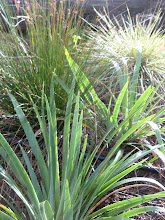
I've been reading a book called The Four Ages of Tsurai, which is a compilation of the European accounts (including one by botanist Archibald Menzies) of the small Yurok village of Tsurai, which was just below the modern town of Trinidad, where I go for internet and library books.
"Olega’ “where they come.” A place near the end of the present wharf which got its name because objects continually drift ashore there."

Trinidad Head is a great place to see plant diversity.
Ribes sanguineum.

The flowers, as you can see, are very beautiful. They're one of the most popular CA natives in cultivation.
 I don't know what this litte plant is. Shame.
I don't know what this litte plant is. Shame.
it would turn out well."



Salal (Gaultheria shallon) is a common plant along the coast. The berries are good in muffins, and have an interesting crunch to them.


Trinidad Head may be the best place to find Mimulus aurantiacus in this area. I saw it in gardens before I noticed it in the wild. Here's a tiny plant growing on a rock.

Fringecup (Tellima grandiflora) is a common ground cover in the shade, yet we don't have any in Bayside. (Even stranger is our very sparse amount of Oxalis oreganum, the most common redwood forest plant anywhere else.)


Much of the head is covered in deciduous thickets. Thimbleberry, Twinberry, Blackberry, Gooseberry, and...poison oak.
It seems the Tsurai had a name and story for every rock along the coast. I wonder if today's fishermen have named all the rocks (I bet they have).

Joseph Cambell says, "People claim the land by creating sacred sites, by mythologizing the animals and plants—they invest the land with spiritual powers. It becomes like a temple, place for meditation."
History, hikes, and gardening are great ways to build your temple.
Through intermarriage with whites, disease, and migration to reservations, Tsurai faded away and was completely abandoned by 1914. California has a violent history, especially in respects to the orginal inhabitants. (The Wiyots, the Yuroks southern neighbors who inhabitted Bayside, were massacred nearly to extinction.) But the town of Tsurai faded quietly away.
I haven't confirmed this, but according to the book, the site of Tsurai is grown over, but is marked by a great pepperwood tree (Umbellularia californica).
"If aromatic angelica root was burned beneath its branches and a person prayed for rain, the rain would come in two days...Children were warned to stay away from this tree lest bad luck befall them. If an infant died, the mother...hung the cradle in its branches."The world is composed of sacred sites.




10 comments:
Maybe the mystery flower is a kind of Synthyris, but it doesn't look quite right.
Wonderful history plus geography lesson. It seems good and bad luck are a common theme in the myths of all lands. We need to get some of that angelica, it might grow here in TN. for some added luck. Love the photo with the spider web, aren't spider webs good luck also? ;->
Frances at Faire Garden
I want to take a walk with you! When you see what my back yard looks like (I'll have it posted by tomorrow) you'll see why I'm so envious.
And now I see how Frances @ the Faire Garden got to my blog!
So much to see, so little time. I've never been so far north as this. Some day...
Great picture of the pier, btw. What are people fishing for?
Wait, is that Angelica, or Heracleum?
I think the bottom one is Angelica, but the top two (including the remnant inflorescence) is Heracleum.
I could be wrong. I'm drunk right now.
Hey Chuck, people fish for all kinds of things. I think it's mostly rockfish, crab, and lingcod these days.
You're right, there is something going on with the "angelica." The one in the last picture has a bunch of umbels on one stalk, but the dead stalk I show only has one...so something's going on. But the stalk was too short to be Heracleum, unless it was just a piece of what was left. Or maybe the side umbels of the angelica disintegrated. I don't really know. And I'm not familiar enough with their leaf differences. I better look into this further.
In case you don't know about it, you can read Kroeber's Handbook online. Depending on your tolerance for early 20th-century anthropology.
MMW, I recently found a management plan for Tsurai online(http://www.trinidad.ca.gov/documents/Final%20TMP%20May%202007.pdf). I haven't had time to really read that yet, so it may be a while before I get to Kroeber, but I appreciate the link.
Oh, and I've keyed out that little mystery flower to the best of my ability and came up with Synthyris reniformis, whose blooms are lavender to white. It doesn't quite match the Jepson Manual sketch, but I think that may be because it's just emerging. If anyone can correct me, please do.
Post a Comment